Metal sink: characteristics, types, features
Steel sink for the kitchen is a very popular and demanded sanitary fixture. Love housewives stainless steel sink won a lot of positive qualities, among which - ease of care, beautiful appearance and ease of use. We want to tell in more detail about this class of kitchen sinks.
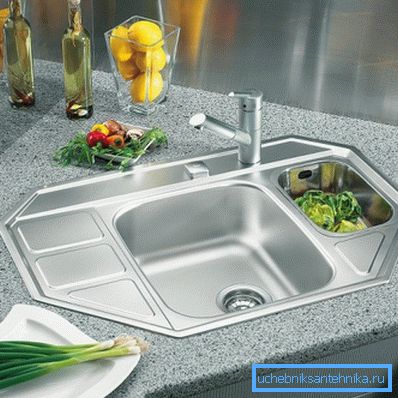
Stainless Steel Kitchen Sink
Construction features
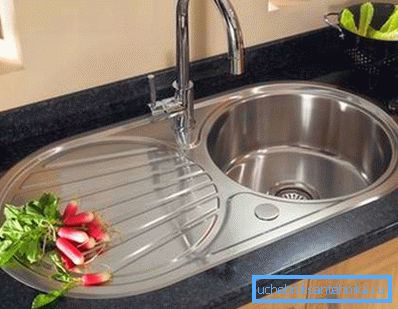
In fairness it should be noted that not only stainless steel models are related to metal washes. We all remember (and some use now) shells of Soviet manufacture, made of ordinary steel and coated with enamel.
However, today such products are becoming less common, as they are morally obsolete, and new technologies make it possible to completely replace them with more successful counterparts from steel alloys with chromium and nickel.

The fact is that ordinary steel fits very poorly with the conditions of the kitchen, because even a thick layer of good enamel is erased over time, and if you consider that dishes that scratch and peel off the floor are constantly washed, it is difficult to predict the service life.
If we talk about stainless steel sinks, here we see a completely different picture: the material perfectly tolerates prolonged contact with water and does not need to be coated or enameled at all. Individual models can be painted, but this is done solely for reasons of beauty and design.
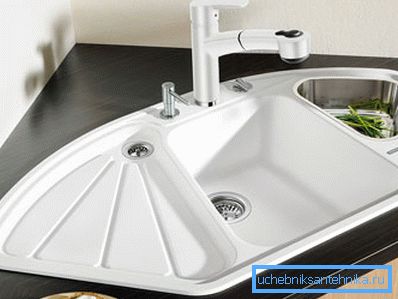
For the production of modern devices use a special stainless steel - an alloy of steel, chromium and nickel, and quality models differ in a certain composition and proportion.
So, the combination of 10% nickel and 18% chromium is considered the most successful: it is this proportion that allows you to create durable, lightweight, anti-corrosion devices, and at the same time an effective surface luster is achieved, for which these shells are so loved by many buyers.

By the way, the surface can be glossy or matte, to someone that is more to their liking. Over time, a cobweb of small scratches inevitably appears on a glossy surface, they are not particularly noticeable and do not spoil the appearance, but for some it is a significant nuance. On the matte models of these little things are not visible.
Species
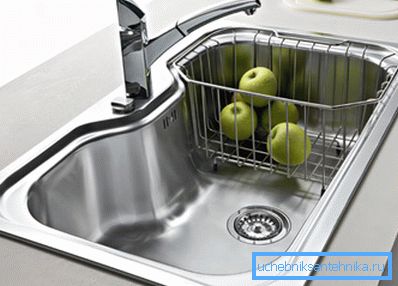
The first and main criterion for the classification of stainless steel appliances should be considered the method of their production.
There are two ways:
- Stamping. The result is a solid, monolithic and seamless bowl, which is its undoubted advantage. However, thin metal is used for stamping, which is noisy and deformed with significant blows; moreover, the maximum depth of such a shell is only 15 to 16 centimeters;
- Welding. This method allows you to create bowls of virtually unlimited depth, and the thickness of the walls is selected to the most appropriate operational requirements. Such models are stronger, deeper and are considered to be of higher quality.

Note! At observance of the production technology both types of sinks turn out rather qualitative and serve all term of operation without problems.
When choosing a product should pay attention to the thickness of the metal (in the case of stamped models) - it must be uniform. If the technology is not followed in individual terms, stretching and thinning of the metal can be observed, which is a sign of a poor-quality product.
For welded structures, an important indicator of quality is the state of the welds: they must be solid, smooth and continuous. Sometimes it is difficult to identify welding defects by eye, therefore it is better to give preference to proven manufacturers with a good reputation.
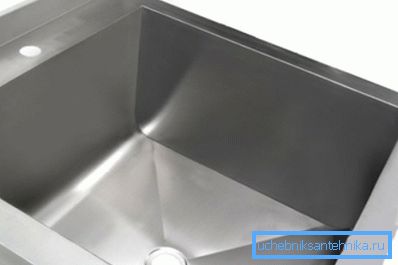
Sinks are overhead, mortise and integrated. Due to the special qualities of steel, installation of products is easy to do by hand with the help of special fasteners, clamps or brackets.
Forms and purpose of sinks also differ in a variety: there are square, rectangular, angular, round, oval models and variants with a complex configuration. There are examples of one, two or three bowls, additional details for drying dishes and washing vegetables.

Stainless steel sinks have become very popular among summer residents. In addition to the bowl itself, there is a metal bollard under the sink for the dacha, which perfectly transfers operation in the open air.
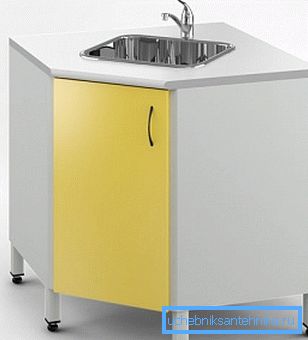
Note! If you do not like the sound of water, then you can use a welded model of thick steel with noise absorbing coating.
Advantages and disadvantages
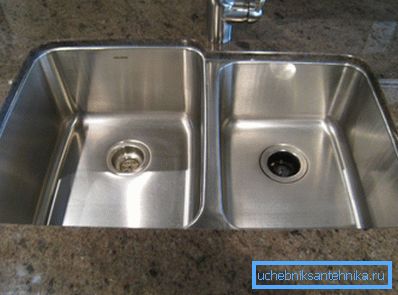
For the objectivity of our review, you should list the pros and cons of this product.
Let's start with the positive points:
- High functionality. Modern technologies allow to produce almost any shape of products, and as a result we get a real multifunctional kitchen appliance;
- Affordable price. In comparison with stone and porcelain counterparts, metal sinks are quite accessible to the wide consumer;
- Easy care. The surface does not absorb any substances, and it is enough to simply wipe it dry. As a result of prolonged wear, no stains or large scratches appear on it and it does not change color;
- No corrosion. The steel alloy with nickel and chromium does not rust when interacting with hot and cold water, oxygen and household chemicals;
- The bowl is strong enough, to withstand shocks and pressure, but at the same time it is elastic so that the falling dishes do not break;
- Installation instructions are simple and understandable., work does not require the possession of any special knowledge and skills.
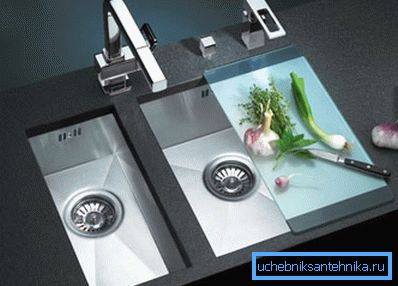
Note! This class of kitchen appliances can be called the most versatile, since at a low price, products can satisfy almost any operational requirements.
The disadvantages of metal sinks include the following:
- When using the device there is quite a noticeable noise from the water falling into the bowl. Noise is especially heard when using stamped models due to thin metal. There are welded products with special noise insulation, but they are more expensive;
- Scratches inevitably appear on glossy surfaces. They are quite small, but visible at certain angles;
- If the sink is not wiped dry, it will remain traces of droplets, water leaks and splashes. Also on the gloss fingerprints and hands are clearly visible;
- The color range is limited to shades of gray and silver colors. Painted models, as a rule, are available in limited editions and are expensive.
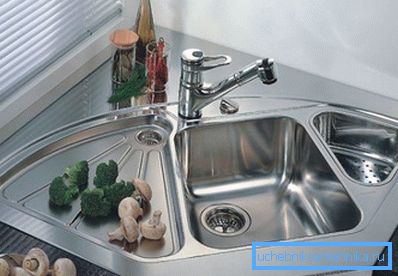
Conclusion
Sinks from metal - an example of the most functional, inexpensive and reliable kitchen appliances. Their installation is simple, and operation - convenience. The video in this article will help you choose the right model for your kitchen.